613 Search Results for a year of core
August 11, 2015
by Carole Zangari -
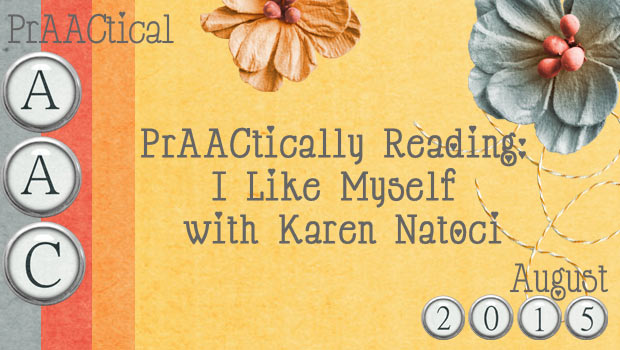
Karen Natoci is back with some wonderful ideas for building AAC skills using the book, I Like Myself. Check out her lesson plan and suggestions for some prAACtical reading ::::::::::::::::::::::: Book: I Like Myself!, by Karen Beaumont; Illustrated by David Catrow (Scholastic Inc.) Core Vocabulary focus: I, WANT, LIKE, ME/MY, SAME, DIFFERENT, GO, IN, DO, Fringe Vocabulary focus- Body Parts: eyes, ears, nose, fingers, toes, head, Opposites Vocabulary use: wild/tame, fast/slow, Core Vocabulary focus: I, LIKE, ME/MY, Fringe Vocabulary focus- Abstract VERBS: Think, say, COMMUNICATION Matrix (Rowland, 2009) Level: I-VII ——————————————————————– School is just around the corner and the planning begins! Our school year started in mid July. During the first two weeks, we decided to focus on the shared reading of: I Like Myself! by Karen Beaumont. This book is thoughtful, has great rhyme and rhythm, and is illustrated beautifully. It is a great way to think about the... [Read More...]
August 6, 2015
by Carole Zangari -
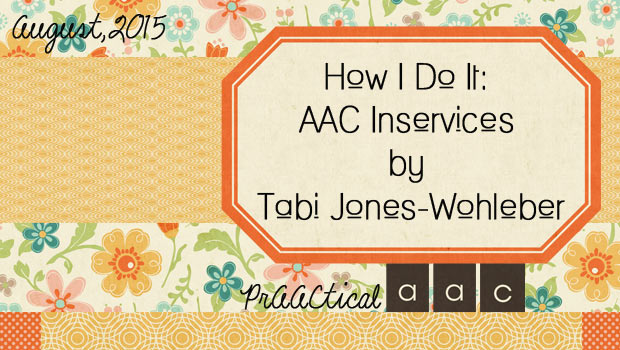
Many SLPs involved in AAC service provision are called upon to provide inservice training on implementation strategies. In this post, we are very fortunate to have Tabi Jones-Wohleber back to share both her thoughts and training materials. Tabi, an SLP on the AT Team for Frederick County Public Schools in Maryland, wrote two previous posts for us. In those posts, Tabi shared her All-in-One Visual Support Tool and Classroom CORE Tool. Today, we hear about her experiences with professional development for teachers, aides, and therapists who serve students with AAC needs. ::::::::::::::::::::::::::::::::::::::::::::::::::::::::: Implementing AAC: A Picture…AND…A Purpose As I work with staff and students to support implementation of AAC, I’ve learned 2 important things about making it work: 1) Folks need to know what it looks like “in their classroom/life” AND 2) effective implementation does not emerge from directives, but rather evolves from understanding, engagement and ownership of the WHAT... [Read More...]
July 6, 2015
by Carole Zangari -
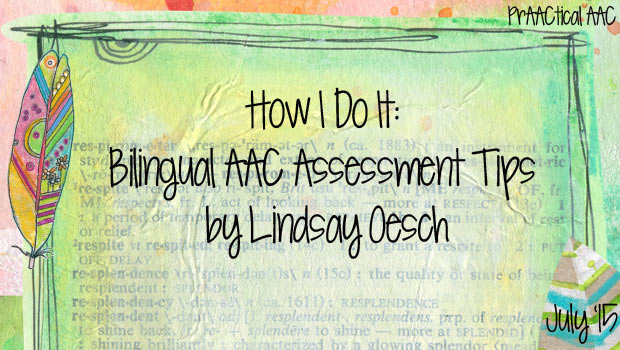
One of the things that I love most about where I live is the rich mix of cultural heritages and linguistic backgrounds in the clients we serve. It can be challenging to do a good assessment, though. Today, we hear from Lindsay Oesch who shares her thoughts on AAC assessments with children from bilingual environments. Don’t miss clicking through to get the parent questionnaires and other resources she shares in her post. :::::::::::::::::::::::::::::::::::::::::::::: Beginning the AAC Assessment Process with Bilingual Children As a clinician in New York City, it is so exciting to be working with children ages 5-12 as a speech-language pathologist in one of the most culturally and linguistically dynamic places in the world. It has also remained a major challenge to assess and treat children with speech and language impairment/delay who speak more than one language, in order to accommodate their specific language needs. Assessment for a communication... [Read More...]
June 22, 2015
by Carole Zangari -
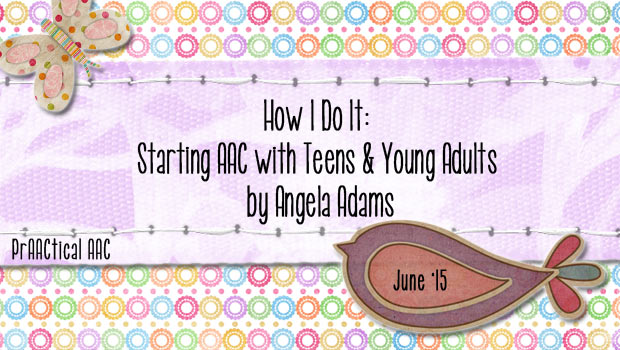
Today, we welcome back Angela Adams, a Washington-based SLP. She currently works with students aged 11- 21 years in a small school district in the Pacific Northwest. Angela has 14 years experience, in both private practice and public school settings. She has a passion for helping adolescents and young adults with AAC needs develeop their communication skills. In this post, she shares some thoughts on getting older students started on AAC. ::::::::::::::::::::::::::::::::::::::::::::::::::::::::::::::::::::::::::: What do you do when the new user of AAC is a teen or young adult? Core vocabulary, phrase-based communication, category- and topic-based pages….so many options for the new AAC user. THE CHALLENGES ARE REAL: What happens when the new user is a teen or a young adult? When in the public school system, what happens when this teen or young adult will only be our student 5 more years or 3 more or 1 more? What about our new AAC users... [Read More...]
May 18, 2015
by Carole Zangari -
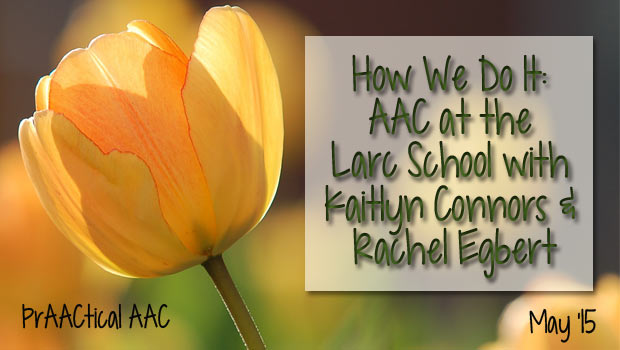
In honor of ASHA’s Better Hearing and Speech Month, we’ve invited clinicians who use AAC in their schools to share a bit about their work here on PrAACtical AAC. Today’s post is from Kaitlyn Connors and Rachel Egbert, two school-based SLPs in New Jersey. For the past 8 years, Kaitlyn has worked with children who use AAC. She earned her Master’s degree from Ithaca College and remains passionate about AAC, and helping each student communicate to the best of their abilities. Rachel earned her Master’s degree from the University of Nebraska at Omaha in 2013. She eagerly keeps abreast of the latest advances in AAC, which help her to deliver the most positive outcome possible for her students. Both Kaitlyn and Rachel currently serve students at Larc School. Beyond Requesting: PrAACtical Ideas for Building Language in the Classroom To take one student beyond requesting during snack time we implemented a core language board... [Read More...]
April 2, 2015
by Carole Zangari -
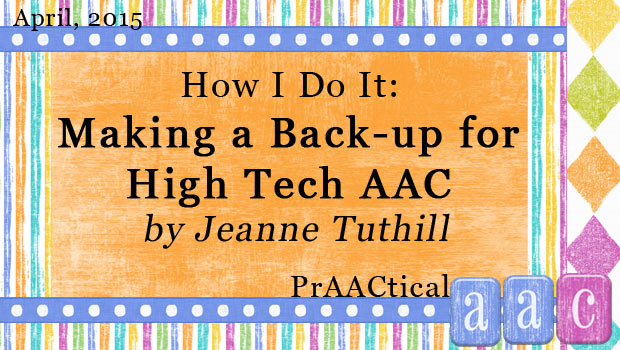
If you’ve ever woken up in the middle of the night sweating over one of your AAC clients who doesn’t have a back-up communication tool, then this post is for you. Jeanne Tuthill is back with another prAACtical suggestion, this time on the importance of ensuring that people with AAC needs have communication options when their technology isn’t available or appropriate. In keeping with the generous spirit of the AAC field, Jeanne also shares her files for this project. Enjoy! How I Do It: Making a Back-up for High Tech AAC Each time I teach my graduate class I try to invite at least one AAC user in as a guest speaker to share their story with the students in the class. It never ceases to fill my students with awe and appreciation for the challenges that AAC users face on a daily basis. My students often list it as... [Read More...]
March 5, 2015
by Carole Zangari -
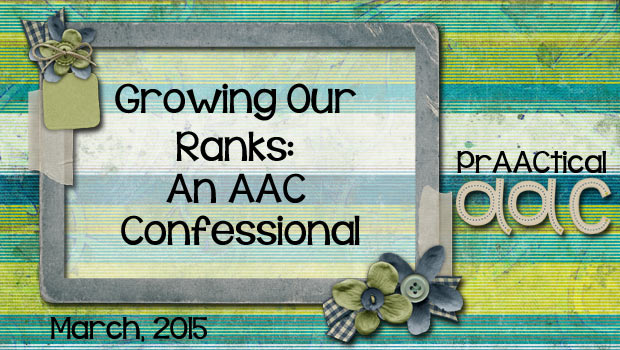
It’s funny where life takes you. A former student of mine was unhappy as an attorney, but found deep satisfaction in becoming an SLP. Another one enjoyed her work as an SLP, but reached even more lives by founding a company for low tech communication and literacy materials. As SLP students, we might not have considered the role that people with AAC needs would play on our caseloads. And with over 90% of school-based SLPs serving kids with autism, my guess is that many who are now supporting nonverbal or minimally verbal students had no intention of specializing in AAC. And yet, there they are: a language lifeline for students who cannot communicate effectively through speech. I am so grateful to today’s guest author, Sara Barnhill, for sharing her own experience in becoming an AAC service provider. Sara is an SLP who has has worked at Children’s Hospital of Richmond at... [Read More...]
February 12, 2015
by Carole Zangari -

Those of you who are still digging your way out of the most recent snowstorm may not believe it, but it’s almost time to make plans for summer. There are quite a few AAC camps, some that are quite well established and others that have been running for only a few years (see our AAC Camp Pinterest board here). In this post, we hear about one of them from Tina Moreno, an SLP and mom of Mateo, who uses PicturePower 100 on the Maestro to communicate, maintain friendships with his teammates on the cross country team, advocate for himself, reveal his wicked sense of humor, and even sing the National Anthem for his high school’s basketball games. Tina blogs at Voices4All. With the help of Drs. Karen Erickson and David Koppenhaver, she and her friend Gina Cunningham created Camp ALEC together in memory of Gina’s son Alec, who never gave up, and... [Read More...]
February 9, 2015
by Carole Zangari -
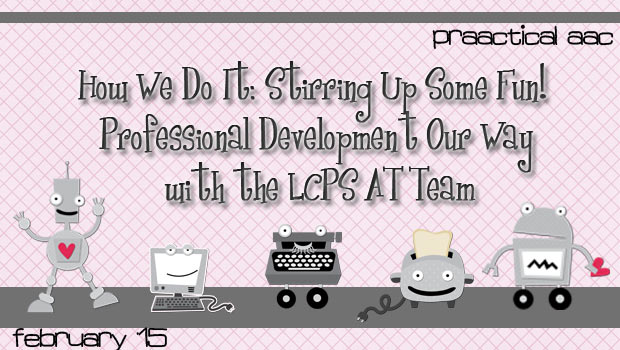
How does the AT team at Virginia’s Loudoun County Public Schools (LCPS) set out to influence their colleagues to learn more about AAC? With digital technologies, of course, along with a heaping dose of fun. In this post, OT Judith Schoonover and SLP Sally Norton Darr share some of the team’s favorite strategies for professional development. Judie has practiced in schools since 1975, working as an OT, elementary school teacher, and an AT trainer in that time. She is a strand advisor for ATIA, and has authored chapters and presented nationally on topics including UDL, adapting books, the relationship between OT and AT, and low tech supports for students. Sally is an SLP and AT trainer for LCPS. She enjoys her work in the public schools and has fun presenting internationally, regionally, and virtually to diverse audiences on a wide range of low to high-tech strategies, interventions, and solutions. Sally is the... [Read More...]
January 5, 2015
by Carole Zangari -
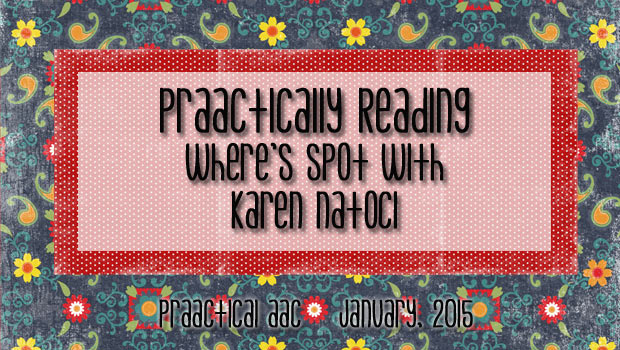
New years bring new opportunities. Today, we welcome back Karen Natoci, but this time in a new role. Karen will be doing a monthly post sharing ideas for interactive book reading with children who use AAC. In her first PrAACtically Reading post, Karen explains how she used book reading to build language and literacy skills. ::::::::::::::::::::::::::::::::::::::::::::::::::::: We had a wonderful time reading Where’s Spot? By Eric Hill. I had both the “big book” and a small, cardboard book. Most all of the pages contain a predictable line: “no!” Since many of my students were learning to say “yes/no” it seemed like a great way to practice this skill as part of SHARED READING. The important part is that everyone in the classroom had access to some form of AAC, including the staff. So, while I was reading the story, I paused and the whole class responded together by using their AAC... [Read More...]









